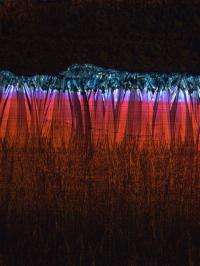Record conductivity achieved in strained lattice organic semiconductor

(PhysOrg.com) -- Organic semiconductors could usher in an era of foldable smartphones, better high-definition television screens and clothing made of materials that can harvest energy from the sun needed to charge your iPad, but there is one serious drawback: Organic semiconductors do not conduct electricity very well.
In a paper to be published online on Wednesday by the journal Nature, researchers at Stanford led by chemical engineer Zhenan Bao have changed that equation by improving the ability of the electrons to move through organic semiconductors. The secret is in packing the molecules closer together as the semiconductor crystals form, a technique engineers describe as straining the lattice.
Bao and her colleagues have more than doubled the record for electrical conductivity of an organic semiconductor and shown an eleven-fold improvement over unstrained lattices of the same semiconductor.
"Strained lattices are no secret. We've known about their favorable electrical properties for decades and they are in use in today's silicon computer chips, but no one has been successful in creating a stable strained lattice organic semiconductor with a very short distance between molecules, until now," said Bao.
In the past, engineers have tried to compress the lattices in these materials by synthetically growing the crystals under great pressure. "But, as soon as you release the pressure, the crystal just goes back to its natural, unstrained state," said Bao. "We've been able to stabilize these crystals in tighter formations than ever before."
Fine-tuning
Bao's team used a solution shearing technique similar to a coating process well known in the semiconductor industry. Solution shearing involves a thin liquid layer of the semiconductor sandwiched between two metal plates. The lower plate is heated and the upper plate floats atop the liquid, gliding across it like a barge. As the top plate moves, the trailing edge exposes the solution to a vaporized solvent and, heated by the lower plate, the crystals form into a thin film.
"Using a process so similar to current industry technology is important, as it could speed these new semiconductors to market," said Bao.
The engineers can then "tune" the speed at which the top plate moves, the thickness of the solution layer, the temperature of the lower plate, and other engineering factors to achieve optimal results.
The crystals form in differing structures based on the speed at which the top plate moves. These differences are clearly evident in photographs. At slow speeds, the crystals form in long, straight structures, in line with the direction the top plate is moving. At higher speeds, the crystals form wildly irregular patterns, and in other speeds the patterns resemble tiny snowflakes.
The engineers next tested the various crystalline patterns for their electrical properties. They found that optimal electrical conductivity was achieved when the top plate moved at 2.8 millimeters per second, a speed in the middle of the range they tested.
"In comparing the photographs of the crystals, it is not the longest, straightest structures that result in the best electrical characteristics," said Bao, "but the one with a shorter, yet highly consistent pattern."
New structures, new analyses
Bao's new semiconductor proved challenging in at least one other regard: Measurement and visualization of the lattices to understand how and why they work. To gain this understanding, she turned to Stefan Mannsfeld, PhD, a staff scientist and expert in x-ray scattering at Stanford Synchrotron Radiation Lightsource, a co-author of the paper.
"We have been able to improve how we analyze the relative brightness of the peaks we can see in x-ray diffraction images," said Mannsfeld. "Previously this was only possible when analyzing relatively big single crystals, but we have for the first time been able to duplicate this for very thin films of these crystals."
With improved analysis, the team was able to understand the physics behind the improvement. "Our analysis made it possible not only to see the impact of the strain on the lattice geometry, but also to determine the exact way in which the molecules pack in the lattice. As a result we obtained a better understanding of why such structures improve the molecule-to-molecule electrical coupling that improves the electrical efficiency," said Mannsfeld.
In the paper, Bao describes her new technique as general enough as to be applicable to other materials that might someday yield even better electrical characteristics in in a wide range of organic semiconductors.
Provided by Stanford University





















